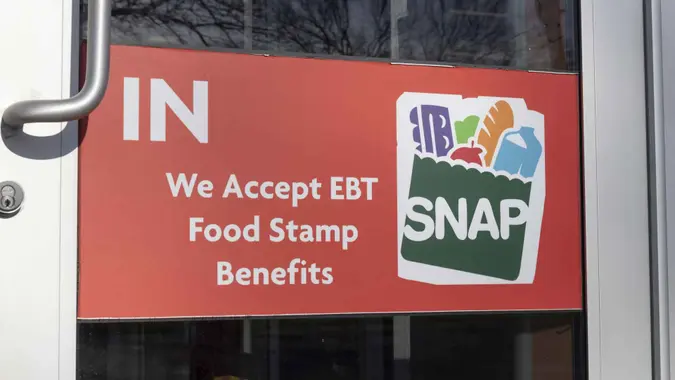I Asked ChatGPT How Trump Ending EV Credits in September 2025 Impacts Car Buyers: Here’s What It Said

Commitment to Our Readers
GOBankingRates' editorial team is committed to bringing you unbiased reviews and information. We use data-driven methodologies to evaluate financial products and services - our reviews and ratings are not influenced by advertisers. You can read more about our editorial guidelines and our products and services review methodology.

20 Years
Helping You Live Richer

Reviewed
by Experts

Trusted by
Millions of Readers
ChatGPT has its pros and cons, but one thing it’s good at is assembling information from online sources and presenting them in a readable fashion. This makes searching for information regarding President Trump’s ending of electric vehicle (EV) tax credits in September a perfect chore for the AI bot. Below is what ChatGPT pulled together regarding the end of EV credits in 2025 and how it will impact car buyers.
Also here is a popular loophole to still score the EV tax credit.
What’s Specifically Changing?
Until Sept. 30, qualified new EV buyers can still get up to $7,500 in the form of a tax credit. Used buyers may be eligible for a credit of up to $4,000, with some restrictions. But the One Big Beautiful Bill Act or OBBBA, eliminates the credits for both new and used EVs as of that date.
For those cutting it close to the deadline, it’s important to note that delivery does not have to occur before Sept. 30. What’s important is that you’ve signed a contract with a deposit or payment before the deadline.
What Does This Mean for EV Buyers?
Some of the consequences of the EV credit expiration are obvious. For starters, this means that EVs will effectively cost more for most buyers after Sept. 30. There might also be a “gold rush” at dealers in the last two weeks of September as buyers potentially flood dealer lots trying to cash in before the credits expire. But here are some additional consequences listed by ChatGPT:
- More emphasis on local and state incentives: Federal EV credits aren’t the only game in town. Those offered by various states and municipalities may see growing importance in terms of incentive pricing. Buyers should do their homework and see what non-federal credits may still be available, both before and after Sept. 30.
- Sales may slow after Sept. 30: If you wouldn’t qualify for an EV credit anyway, you might be rewarded by purchasing an EV after the deadline. As demand is expected to wane once the tax breaks go away, dealers may have to offer their own incentives to purchasers after Sept. 30. This puts post-deadline buyers in the driver’s seat when it comes to negotiations, including in the leasing market.
- Used EVs may drop in value: ChatGPT noted that used EV values might shift as well if demand drops after the credits end. Resale and trade-in values are likely to fall as used EV buyers can no longer avail of the federal tax credit. This could also open up opportunities for buyers.
Steps To Take Now
If you find yourself rushing to get an EV before the credits expire, here are the action steps that ChatGPT suggests you take:
- Act before Sept. 30: If you’re in the position to do it, at least put down a deposit to lock in your purchase, even if you can’t take delivery until after the deadline.
- Check eligibility of the specific EV model (new or used): Not all vehicles qualify for the federal credit to start with, so don’t rush in without knowing all of the facts. Some of the factors that could impact eligibility include assembly location, battery/mineral sourcing, dealer, price and so on.
- Compare total costs, not just sticker price: This part of the equation often gets overshadowed by the large $7,500 credit. When determining whether or not an EV is a value, factor in not just the federal credit and any state or local incentives but also likely charging costs, maintenance, utility/charging cost savings and so on.
- Explore state and local incentives: As mentioned above, federal credits are not the only game in town. Some states may step up or boost incentives to make up for the loss at the federal level. Where you live may actually end up mattering a lot.
- Consider transportation alternatives in your budget if the cost of EVs rises: It’s a simple fact that without the federal credits, other alternatives, including hybrid, PHEV or even highly efficient gas models, may actually make your purchase more cost-competitive.
- Plan for resale and charging infrastructure: Even after the subsidies expire, two factors can help maintain the value of your EV: the quality of the charging infrastructure in your area and the overall demand for electric vehicles relative to other locations.
If you’re looking to snag EV tax credits before they expire — and potentially never come back — you’ve got to act fast. While you should never rush into a financial transaction, particularly one that is likely to be the second-largest in your life after buying a home, in this case, haste could translate to thousands of dollars in savings.
Editor’s note on political coverage: GOBankingRates is nonpartisan and strives to cover all aspects of the economy objectively and present balanced reports on politically focused finance stories. You can find more coverage of this topic on GOBankingRates.com.
 Written by
Written by  Edited by
Edited by 

























